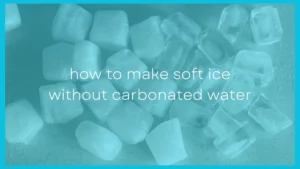Ice is often used to keep food and beverages cold, but some materials make ice melt faster than others. Ice melts faster on aluminum than plastic, but why is that the case?
ice melts faster on aluminum than plastic because aluminum is an excellent heat conductor whereas plastic isn't. When ice is placed on aluminum the heat from the metal can be quickly transferred into the ice melting it (and making the aluminum block cold) whereas plastic doesn't transfer its heat into the ice as quickly.
It is the fast transfer of heat that makes aluminum excellent at melting ice.
Aluminum is not the only substance that melts ice faster than plastic, but it is one of the fastest – simply because it is one of the best heat conductors out there.
More information about why aluminum causes ice to melt faster than plastic is below.
How Aluminum Melts Ice Quickly
The average room temperature is 68ºF or 20ºC. A block of aluminum will naturally warm to the temperature of the room it's in
However, when you pick up a block of aluminum it'll feel cold to touch. This isn't because the aluminum is actually cold but because it is such a good conductor it quickly sucks the heat out of your hand giving you the feeling of cold.
When you place a block of ice on aluminum that has been sitting at room temperature then the aluminum will quickly transfer its heat into the ice, making itself cold in the process.
An ice press will use 2 large blocks of aluminum to quickly melt ice into shapes like circles, diamonds and hearts. These are commonly used in whisky and cocktails.
Why Does Ice Melt Slower On Plastic?

Plastic on the other hand is not a good conductor of heat, it's an insulator. This means that heat energy does not transfer through plastic very well.
It also means that plastic is not effective at transferring its heat into the ice. This is why ice will melt slower on plastic when compared to metal.
The plastic transfers its heat into the ice quickly whereas the plastic transfers its heat into the ice at a much slower rate.
Plastic isn't the best insulator to keep ice from melting, but it is definitely up there as one of the best insulating materials.
Can Aluminum Stop Ice From Melting?
In some circumstances aluminum can actually stop ice from melting. Aluminum foil can actually be a good insulator and make your ice last longer.
Given how conducting aluminum is this can seem counterintuitive however aluminum has another property, it is a great reflector of thermal radiation.
This means it can reflect away heat.
Because aluminum foil doesn't have much thermal mass the reflective properties can work to stop ice from melting without the conductivity of the foil melting the ice too quickly.
I recently did an experiment to see whether or not aluminum foil could keep ice from melting. You can see the result in the video below:
What Occurs When Ice Melts
Water freezes once it reaches 32ºF or 0ºC. A typical freezer brings ice down to 0ºF or -18ºC so when at room temperature the ice needs to warm up a bit before it begins to melt.
Once the ice warms up to 32ºF or 0ºC it'll begin to melt.
Heat, or energy in general, puts molecules into a state of excitement, which causes them to move faster and faster. Water and ice are made up of the same molecules, H2O molecules. Essentially, the only difference between ice and water is that in ice, these H2O molecules are held together by bonds and is solid. Ice molecules move slower than water molecules.
When these molecules heat up and get more energy, they move faster and the bonds between them break. When the bonds between the H2O molecules in ice break in this state of excitement, it changes form and turns back into water. (Source)
Why is Metal a Good Conductor of Heat

The reason why metal is a great conductor of heat is they have what is are called Freely Moving Electrons. These electrons in metal are not bound to the atoms in the metal, which lets them move around freely, especially when the molecules are in a state of excitement and are moving and vibrating more than normal. (Source)
As discussed above, when the molecules in an object are moving quickly, energy is being collected and heat can be generated or even absorbed very easily.
In addition to the electrons being able to move freely in metals, the atoms or ions themselves are packed tightly together. The closeness of the molecules or ions is what allows the metal to conduct heat so well.
Because the ions are close together, the energy (in the form of heat) between the molecules can be transferred quickly. If the ions in metal were not close together, the energy would not transfer as quickly and the metal would not conduct heat and energy as well.
Metals that have extremely close ions conduct heat and energy better than metal that has ions further away from each other.
How Does Metal Transfer Heat to Another Object?
The process of Conduction is the transfer of energy in the form of heat from one object or substance to another. Essentially, in the simplest terms, if something that is hot touches something cooler than it, heat will be transferred from the hotter object to the cooler one until they reach the same temperature.
Most of us personally witness conduction many times on a daily basis but perhaps do not recognize it. If you've ever been cold and you hugged someone who was wearing more layers than you and therefore was warmer in order to keep warm, you were utilizing conduction. A portion of that person's body heat was being transferred to you since you were colder than them.
The same process of conduction is what occurs from metal to other objects or substances. The difference is that metal is an even better conductor of heat, due to the qualities discussed above.
Types of Metals that are Good Thermal Conductors
Since you now understand why metal conducts heat so well, you might be wondering what metals conduct heat the best.
The process of conduction discussed above can be measured as a rate, which essentially describes how fast something happens. This rate is given in the standard units for the SI system, which is in S/m (Siemens per meter). In the United States, the standard units for conduction are mmho/cm (millimhos per centimeter). (Source)
Which Metals are the Fastest Thermal Conductors?
Silver has been found to be the fastest thermal conductor. Silver conducts heat at a minimum of 6.3 times 10 to the seventh Siemens per meter or S/m. This can be represented numerically as 6.3 x 10^7.
Copper is the second-fastest thermal conductor. Copper conducts heat at a minimum of five-point nine six times ten to the seventh Siemens per meter or S/m. This can be represented numerically as 5.96 x 10^7. (Source)
Aluminum isn't quite as conductive as copper but it's easier to work with which is why it's chosen for many applications.
Why are Siver and Copper the Best Thermal Conductors?
Copper has a better structure for conducting heat because of how its electrons are arranged. It is essentially the globally standard conductive metal. This is also partially due to the fact that copper is much cheaper than silver and readily available.
However, silver still has a higher mathematical rate for its conduction speed than copper does. When it comes down to it, the decision of using copper vs. silver for a thermal conductor is really dependent on what you're using it for and how much you need.




